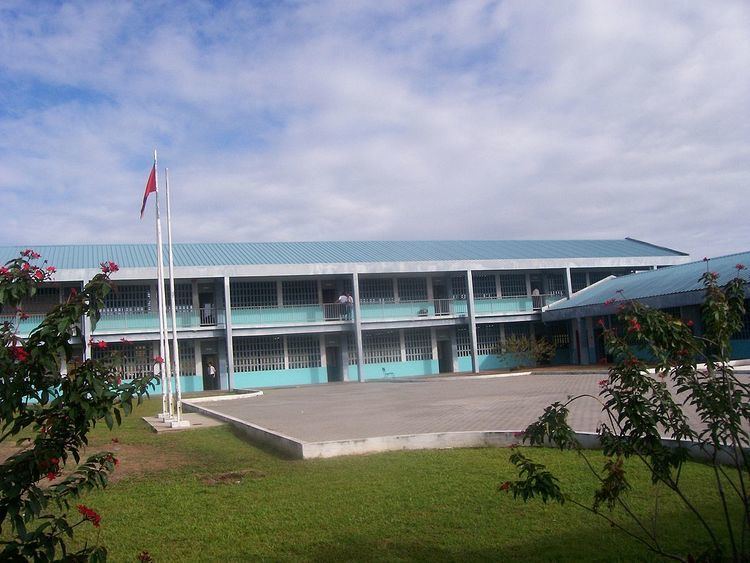Type Public co-educational Principal Romeo Gunness Address Trinidad and Tobago Motto Seize the Day | Established 2000 Age 10 to 18 Phone +1 868-647-2405 Founded 2000 | |
 | ||
Similar Iere High School, Naparima Girls High School, Naparima College, ASJA Boys' College, Cowen Hamilton Secondar | ||
Debe High School is a co-educational high school first established in 2000 which offers forms 1-6. It is situated in south Trinidad in Debe. The school's motto is Şeize the Day.
Contents
Campus
It is surrounded by a plantation of sugar cane. Located in Debe it is a quiet school of a population of about 568 students and 43 teachers. Though situated outside the urban area, Debe High has been highly noted for its discipline and high standards of education. The UWI is being built near the school.
House system
The school has four houses: Scarlet Ibis (Red), Blue Jays (Blue), Humming Birds (Green), and Kiskadee (Yellow).
School structure
The school has 8 blocks.
School composition
Admission to college
Admission to college is determined by performance on an examination.
The current examination is the Secondary Entrance Assessment or SEA. The Division of Educational Research and Evaluation (DERE) and Division of Curriculum Development of the Trinidad & Tobago Ministry of Education describe the 3-hour-10-minute-long SEA as "a mechanism that facilitates placement of students in secondary schools in Trinidad and Tobago". The SEA comprises three papers that must be attempted by all candidates: Creative Writing, Mathematics and Language Arts. The assessment covers the national curriculum for primary-level education for Standards Three to Five, the final three years of elementary instruction.
Debe High tends to be an institution of third choice of the five prospective institutions each examinee is required to list in preferential order of interest prior to the exam. The five preferences are drawn from the totality of secondary institutions nationwide. A candidate is unlikely to gain admission to the College but for performance consistent with the highest examination percentiles.
The precursor to the SEA was the Common Entrance Examination or CEE. The CEE mirrored the SEA in several significant respects.
Students can also be transferred into the school after an entrance exam.
Extracurricular activities
Other extra-curricular groups
Uniform
Girls are required to wear a navy blue skirt 2 inches below the knee. Black shoes, black socks, a white shirt blouse with waist band attached that is fitted over the skirt and a blue, silver, and red tie complete the uniform.
Boys are required to wear navy blue pants, white shirt tucked in the pants, black belt, and black shoes and black socks with a blue, silver, and red tie.
Subjects
The school offers a wide variety of subject choices. Offer to forms 1-3 are Drama, Art, Maths English, Spanish, Physical Education Music, Literature, Social Studies, I.T., Dance, Science (Biology, Chemistry, Physics)
Offered for 4-5 forms. Every child is required to choose 5 subjects out of 8 (Maths, English, and Literature are compulsory) to do in C.X.C. exams.
Choices
Cape is now done at the school.They offer-
Education
Students of the College pursue a course of instruction leading to external examination under the authority of the Caribbean Examinations Council (CXC). After five years at the College - and in selected instances, four years - students sit the Caribbean Secondary Education Certificate (CSEC) examination in various fields of study.
The CXC was established in 1972 by agreement of regional governments seeking an effective and functional model through which to provide and assess a secondary education curriculum reflective of, and sensitive to Caribbean priorities and reality. As a body, the Council has an operative relationship with the University of the West Indies and the governments of fifteen (15) participating territories aside from that of the Republic of Trinidad & Tobago.
The CSEC examinations are the accepted and internationally recognised equivalent of the GCE or General Certificate of Education Ordinary Level examinations they replaced. For decades, examinees at Pres took GCEs set by the University of Cambridge Local Examinations Syndicate, now known as University of Cambridge International Examinations. However, a preceding generation of students took a version of Cambridge examination known as the Cambridge School Certificate, a precursor of contemporary GCE O'levels.
Students at the College first sat CXC exams (CSEC) in 1979. At that time, the subjects available for examination under CXC existed in limited number. The first group of examinees submitted to examination in the areas of English Language (English A), Mathematics and Geography, while also taking Cambridge GCEs in these three subjects and other subjects.
Gradually, the range of subjects offered by the Caribbean Examinations Council expanded until CSEC exams came to replace the traditional Cambridge GCE exams completely.
In everyday parlance, CSEC examinations are commonly referred to as CXCs because from 1979 to 1998 they constituted the only form of examination offered by the Caribbean Examinations Council. However, the Council later developed the Caribbean Advanced Proficiency Examinations (CAPE) examinations to replace the British Advanced level or A-level exams - as they are known throughout the British Commonwealth. The Council's rationale for the change was predicated on the same basis as that supporting the curricular adjustments leading to the introduction of the CSEC.
CAPE examinations are taken by students who have completed their standard secondary education (the CSEC) and who seek to continue their studies, beyond the minimum age for completion of compulsory education.
Students who wish to sit for the CAPE usually possess CSEC or an equivalent certification. The CAPE is the globally recognized equivalent of British A-levels. Students at the College formerly submitted to GCE Advanced Levels through the University of Cambridge Local Examinations Syndicate.
